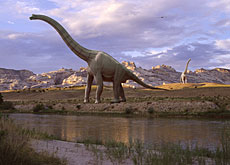
Swiss dig up clues in dinosaur death mystery

Massive volcanic eruptions in India may have spelt the end for the dinosaurs 65 million years ago - not, as previously thought, a meteor smacking into Mexico.
Scientists from Switzerland and the United States have been able to date the eruptions, which created the Deccan Traps lava beds, to within 300,000 years of the mass extinction of the dinosaurs, palaeontology’s most persistent puzzle.
“Increasingly we see that vulcanism is largely responsible for the extinction of the dinosaurs,” Thierry Adatte, a professor of geology at Neuchâtel University, told swissinfo.
“It’s not a definitive answer, but we have more and more data indicating that the combination of volcanic activity, impact and climate change may have been fatal for the dinosaurs, which had already been endangered for at least five million years.”
Adatte and Gerta Keller, a palaeontologist at Princeton University, presented their findings at the annual meeting of the Geological Society of America in Denver on Tuesday.
“We’ve known for ten to 20 years that the huge volcanic activity in India probably had something to do with the mass extinction, but what is new is the accurate dating,” Adatte explained.
“In Rajahmundry, about 1,000 kilometres from the centre of the Deccan Traps we found some marine sediments containing micro-fossils between the lava flow of these huge traps. This gives us a much better approximation of the dating,” he said.
“The only thing we had before was some palaeomagnetic and radiometric data and these are not very precise. Ageing based on the presence of micro-fossils and fossils in sediments is much more precise.”
Using this new data, Adatte estimates the main phase of the Deccan eruptions to have occurred within 300,000 years of the mass extinction 65 million years ago.
“Eruptions create a lot of sulphuric dioxide for acid rain,” he said. “If you calculate the volcanic activity in India, it could be equal to at least ten Chicxulub impacts in terms of sulphuric dioxide and other climate-altering emissions.”
Previous suspect
In the past 550 million years there have been five major events in which over half of animal species died.
The most recent mass extinction, the Cretaceous-Tertiary event – widely known as the K-T extinction event – took place 65 million years ago and has attracted the most attention because it wiped out the dinosaurs.
The main suspect in the K-T event is generally considered a ten kilometer-wide meteor which ploughed into the Yucatán Peninsula in Mexico, creating the 180km-wide Chicxulub Crater.
It is thought that the rapid production of carbon dioxide caused by the destruction of carbonate rocks would have led to a dramatic greenhouse effect and sunlight would have been filtered out by dust particles in the atmosphere. The photosynthesis of plants would also have been interrupted, affecting the entire food chain.
Meteors not enough
Adatte doesn’t totally dismiss the Chicxulub meteor theory.
“I wouldn’t say that there weren’t meteor impacts around the K-T boundary, but I would say that an impact by itself is not enough to cause a mass extinction,” he said. “You need something more – and that could be this volcanic activity.”
The Swiss geologist says the next step is to explore the onset of the main phase of Deccan volcanism: the rocks directly beneath the main phase lavas at Rajahmundry.
This will require drilling into the Rajahmundry Traps, a project now scheduled for December 2007 or January 2008.
swissinfo, Thomas Stephens
Dinosaurs were vertebrate animals that dominated the Earth for over 160 million years, first appearing around 230 million years ago.
At the end of the Cretaceous Period, 65 million years ago, all dinosaurs except for the line that had given rise to the first birds went extinct – triggering one of the biggest mysteries in palaeontology.
The dominant theory us that a meteor collision in Chicxulub, Mexico, and its consequences caused the dinosaur extinction, but some scientists blame multiple impacts, vulcanism and massive global warming.
The Deccan Traps is a large igneous province located on the Deccan Plateau of west-central India.
It is one of the largest volcanic features on Earth, comprising multiple layers of solidified flood basalt that are more than 2,000m thick and cover an area of 500,000 km².
The term “traps” is derived from the Swedish word for stairs, referring to the step-like hills forming the landscape of the region.
The Deccan Traps formed 60-68 million years ago at the end of the Cretaceous period. The gases released in the process may have played a role in the Cretaceous-Tertiary extinction event, which included the extinction of the dinosaurs.

In compliance with the JTI standards
More: SWI swissinfo.ch certified by the Journalism Trust Initiative





























You can find an overview of ongoing debates with our journalists here . Please join us!
If you want to start a conversation about a topic raised in this article or want to report factual errors, email us at english@swissinfo.ch.